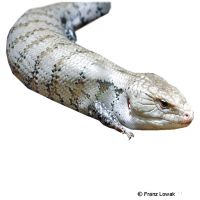Giant Bluetongue Skink (Tiliqua gigas)
| Giant Bluetongue Skink Tiliqua gigas | |
|---|---|
| Name | Giant Bluetongue Skink |
| Name Lat. | Tiliqua gigas |
| Family | Skinks |
| Family lat. | Scincidae |
| Order | Scaled Reptiles |
| Order lat. | Squamata |
| Origin | New Guinea |
| Habitat | Forests |
| Diet | Insects, small mammals, veggies |
| Humidity | 70-90 % |
| Behavior | Peaceful |
| Keeping | Individual, pair |
| Care Level | Moderate |
| Reproduction | Ovoviviparous |
| Housing | Humid terrarium |
| Life Span | 15-20 years |
| Protection | No |
| Metric Units | |
| Size | 58 cm |
| Temperature | 25-28 °C |
| Temperature Local | 30 °C |
| Housing Size | 180 x 120 x 90 cm |
| US Units | |
| Size | 23" |
| Temperature | 77-82 °F |
| Temperature Local | 86 °F |
| Housing Size | 70" x 45" x 35" |
Distribution and habitat
The range of the diurnal giant blue-tongued skinks extends from New Guinea through the neighboring islands to northern Australia. They live in the tropical lowland rainforests, where they mostly stay in the fallen leaves, under tree stumps and roots.
Maintenance
Minimum dimensions for the terrarium, according to the size and number of animals
| 1-2 animals | 6KRL x 4KRL x 3KRL (L x W x H) |
Head-torso length (KRL) is measured on the largest animal. For each additional animal, increase the footprint by 15%. A terrarium of e.g. 180 x 120 x 90 cm is recommended, which should be placed in a quiet and vibration-free place
They need a humid terrarium with flat climbing branches, roots, stone structures (hiding places, privacy screens) and structured back and side walls (e.g. cork lining) as well as a shallow water bowl and a deep substrate suitable for digging. A soil-peat mixture covered with some foliage and bark mulch is suitable for this, as well as robust planting for decoration (ficus, ferns, mosses, etc.). The substrate should always be kept slightly moist. Several times a day the inside of the terrarium should be finely sprayed with water (humidity), but better is a rain or fog system
| Temp. day: 25-28 °C | Temp. night: 20-22 °C | Temp. local: up to 30 °C | Humidity: 70-90 |
Thermostatically controlled floor heating is recommended. Lighting duration must be 12-14 hrs. depending on the season. Daylight fluorescent tubes are ideal. They need sunny places with radiant heat and daily UV irradiation.
Diet
According to their size, the food offer consists of live insects, such as crickets, house crickets, grasshoppers, zophobas etc., earthworms, nest young mice and raw minced meat with egg, supplemented with sweet fruit (e.g. bananas), fruit and oatmeal porridge as well as finely chopped vegetables. Ready-to-eat foods for insectivorous reptiles are also frequently accepted. Wax moths should rarely be fed in very small amounts because of their large fat content. Regular addition of minerals and vitamins (e.g. by dusting the food) is important. Young animals should be offered food daily, adults 4-5 times a week. Drinking water must always be available
A varied diet promotes health and prevents deficiency symptoms.
Reproduction and breeding
The sexes are difficult to distinguish. Males have a thickened tail root. A reliable sex determination is only possible by testosterone determination or endoscopy.
They are viviparous (ovoviviparous) and a litter consists of 8-13 young after a gestation period of 4 months. Small insects, fruits and fruit pulp are suitable as initial food for the young.
Life expectancy can be 15-20 years.
Important
They are compatible, easy to socialize animals that often become food tame.
Typical for the species is their blue tongue, which is used to detect prey and to scare off enemies.
The floor temperature should always be slightly lower than the air temperature. Care should be taken that waterlogging does not form and that the substrate does not become boggy.
They need sunny places with radiant heat, e.g. climbing branches or stones irradiated with a spotlight.
The terrarium must have good ventilation without drafts and meet the species-specific needs. Measuring devices such as thermometers, hygrometers, etc. are necessary. The lighting has to correspond to the species-specific day-night rhythm and has to be placed in such a way that the animals cannot injure themselves. The terrarium should be locked in such a way that neither unauthorized persons can open it nor the animals can escape. Contamination must be removed regularly
Further literature can be found in your pet store.
References
Text: petdata; Image: Franz Lowak
Source: BMELV (1997): Tierschutzgutachten - Mindestanforderungen an die Haltung von Reptilien; ENGELMANN (2006): Zootierhaltung - Tiere in menschlicher Obhut: Reptilien und Amphibien, Harri Deutsch Verlag
- Gemäß § 21 Abs. 5 Tierschutzgesetz idgF
